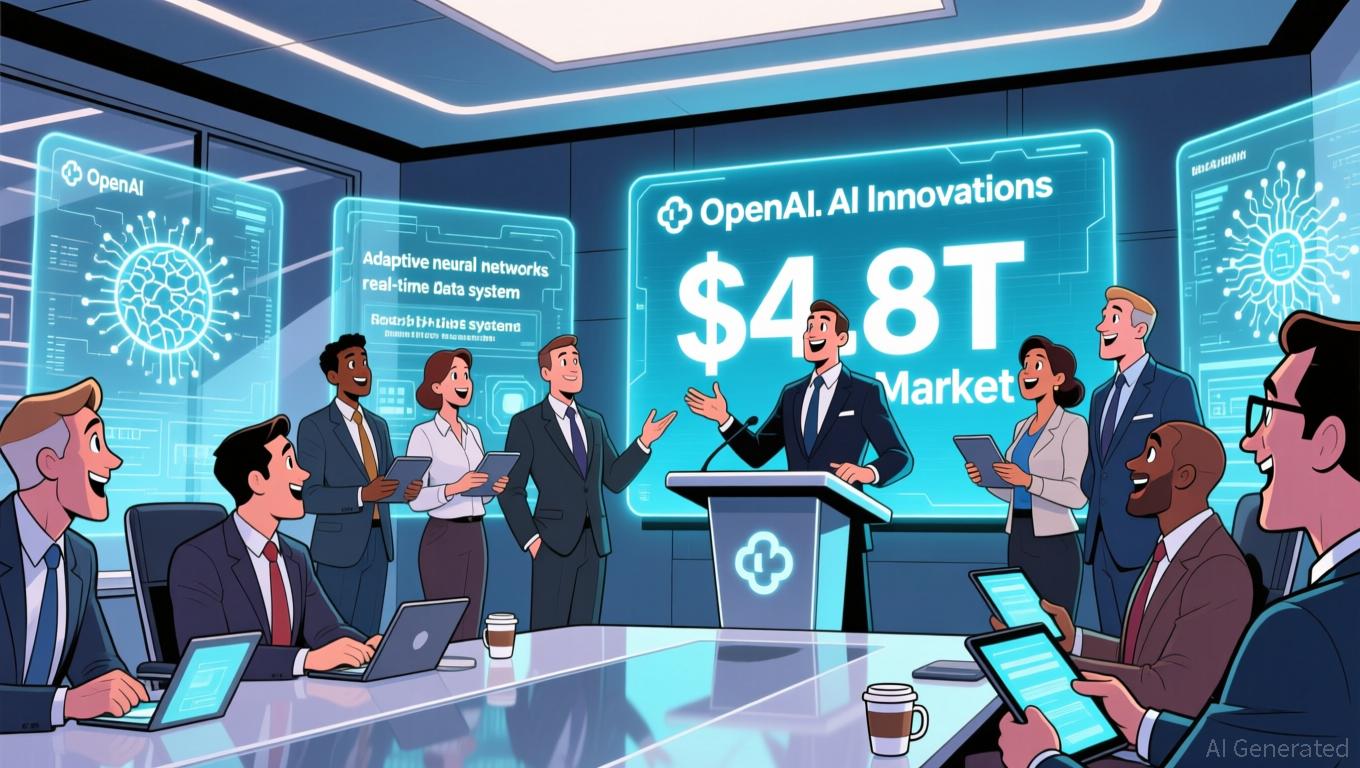Investor Excitement Rises as OpenAI's Breakthroughs in AI Aim for $4.8 Trillion Market
- OpenAI's rumored 2027 IPO sparks speculative trading, with indirect investments surging 108% as investors bet on its $4.8T AI market potential. - Product innovations like Operator AI and o1 model, plus $11.6B 2025 revenue projections, highlight OpenAI's disruptive potential in tech sectors. - Young investor Samik Sidhu's $72,700 AI-linked gains mirror broader trends, as Microsoft-NVIDIA partnerships and Stargate Project amplify expectations. - Legal risks (copyright lawsuits) and Microsoft dependency con
OpenAI’s Possible IPO Ignites Investor Excitement Amid AI Industry Surge
The artificial intelligence industry is energizing financial markets worldwide, and speculation about OpenAI’s potential IPO has intensified trading activity and investor confidence. Although OpenAI has not confirmed a specific date for going public, rumors of a 2027 listing have already led to increased indirect investments in its affiliates and a 108% theoretical price increase in speculative trades, as outlined in a

Recent product releases from OpenAI, including the Operator AI agent and the o1 model, have further fueled investor interest. Operator, now accessible to U.S. ChatGPT Pro subscribers, automates web-based tasks and is set for international expansion, while the o1 model is designed to lower software development expenses, according to the Capital.com guide. These advancements, along with a projected $11.6 billion in revenue for 2025, highlight OpenAI’s potential to shake up established tech industries. Still, there are notable risks: regulatory hurdles, such as a copyright dispute over training data, and heavy reliance on Microsoft’s Azure platform could slow momentum after the IPO.
Investor enthusiasm extends beyond major institutions. This year, 17-year-old Samik Sidhu made headlines by using profits from his e-commerce businesses to invest in AI-related stocks, earning $72,700 in less than twelve months. Sidhu’s investments included Nvidia and C3.ai, which he credited for benefiting from the AI surge. “I caught the AI wave at the perfect time,” he remarked, noting that AI tools improved his e-commerce performance, as detailed in a
The Stargate Project—a $500 billion AI infrastructure collaboration involving OpenAI, Microsoft, and major tech firms like NVIDIA—has further raised expectations. However, experts warn that excessive dependence on a few key partners could make OpenAI vulnerable to market swings. For example, IBM’s slower adoption of AI, shown by limited growth in government contracts, illustrates the difficulties of expanding AI in specialized markets, according to a
Despite these concerns, the appeal of the AI industry remains strong. OpenAI’s partnerships, especially its integration with Microsoft’s Azure, position it well to meet enterprise needs. At the same time, speculative trading through contracts for difference (CFDs) enables investors to wager on OpenAI’s future stock value without owning shares directly, the Capital.com guide explains.
As the possibility of an IPO draws nearer, investors are watching OpenAI’s legal and regulatory situation closely. The ongoing lawsuit with Elon Musk, who claims the company is prioritizing profits over safety, could affect its image. On the other hand, efforts to lead in AI governance may strengthen its standing as a responsible innovator, according to the Capital.com guide.
For now, investors are encouraged to monitor indirect opportunities through Microsoft, Nvidia, and other AI collaborators. When OpenAI eventually goes public, it could transform the technology sector—but until then, the Capital.com guide advises that patience and prudence are essential for investors.
Disclaimer: The content of this article solely reflects the author's opinion and does not represent the platform in any capacity. This article is not intended to serve as a reference for making investment decisions.
You may also like
YFI - Decreased by 44.53% Year-Over-Year as of November 6, 2025 During Ongoing Decline
- YFI fell 0.6% in 24 hours, extending a 44.53% annual decline amid sustained market pressures. - Analysts note bearish technical signals: oversold RSI, weak buying pressure, and failure to breach key moving averages. - A backtesting strategy examines historical 10%+ single-day drops to assess YFI's post-decline recovery patterns and risk profiles.
Ethereum Updates Today: DeFi's 'Code Before Capital' Movement Challenges Centralized Crypto Power
- Major Ethereum DeFi protocols form EPAA to counter centralized crypto firms' influence in U.S. policymaking and promote onchain solutions in regulation. - The alliance, managing $100B+ in assets, emphasizes technical pragmatism over financial lobbying, collaborating with groups like DeFi Education Fund. - Unlike centralized PACs like Fairshake ($260M raised), EPAA provides policymakers with blockchain insights on smart contracts and decentralized governance. - With no formal leadership, the coalition aim

ZEC Climbs 3.55% as Investors Show Support and Derivative Positions Expand
- Zcash (ZEC) surged 3.55% in 24 hours, hitting $490.4, driven by institutional interest and endorsements from figures like Naval and Arthur Hayes. - Derivatives markets show growing speculative demand, with a $13.7M leveraged long position on Hyperliquid reflecting heightened bullish sentiment. - Privacy coin sector valuation rose 2.9% to $25.5B, supported by ZEC's 780% year-to-date gains and increased trading volume of $3.87B. - Technical backtests analyze ZEC's 5%+ daily surges as momentum signals, with
DASH Drops 13.71% Following Q3 Earnings Shortfall and Announcement of 2026 Investment Strategy
- DoorDash's Q3 2025 earnings showed revenue above estimates but EPS below, leading to a 13.71% post-earnings stock drop. - Despite strong 25% YoY GOV growth and 13.8% net margin, 2026 investment plans raised short-term margin concerns. - Deliveroo acquisition's adjusted EBITDA contribution dropped by $32–$40M in 2026 due to accounting adjustments, adding investor uncertainty. - Backtesting suggests EPS misses correlate with downward price pressure when paired with significant capital allocation announceme